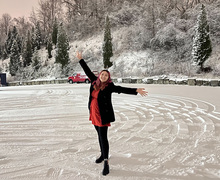The ‘model minority’ trope doesn’t represent Asian Americans
Cole Ross | Digital Design Editor
The "model minority" stereotype is harmful for many Asian American communities, writes our columnist. Contrary to popular belief, Asians Americans face similar discrimination as other marginalized groups in the U.S.
Get the latest Syracuse news delivered right to your inbox.
Subscribe to our newsletter here.
When asked to give three adjectives to describe Asian Americans, the top two responses among Americans were “intelligent/smart” and “hard-working” – 19.4% and 9.3%, respectively, according to a 2021 report by nonprofit Leading Asian Americans to Unite for Change (LAAUNCH). Often a result of long-standing tropes, these stereotypical associations have constructed the common myth of Asian Americans as a monolithic, successful group of racial minorities known as the “model minority.”
As the fastest growing racial group in the U.S. with origins from dozens of countries, these stereotypes obscure the reality of economic inequalities and hardships that many Asian Americans are facing due to the simplistic categorization.
Asian Americans have historically been, and remain to be, highly-divided in their economic and education levels based on their ethnic identity. While many Indian and Chinese Americans have high levels of education and income, Burmese Americans are one of the lowest-earning groups and have a high education rate of 23%. More than 2.3 million Asian Americans, or one in 10, lived below the federal household poverty line of 12,500 dollars per year in the year 2022, according to data from the Pew Research Center.
In the face of this, the “model minority” trope employs an incorrect aggregation of identity that disempowers many Asian communities from getting the help and government assistance they need.
To confront this issue, the U.S. government is implementing significant changes to its racial and ethnicity categories of federal forms that will be also used in the next census in 2030. Per an announcement released by the Office of Management and Budget on March 28, the updates to the census add more options within the “Asian” section for people to indicate their country of origin.
These modifications in official policies aim to better recognize the diversity within the Asian American community, representing a substantial step forward in dismantling the harmful model minority stereotype.
The term “Asian Americans,” first coined in 1968 to replace the colonialist term “oriental,” has been criticized for its vagueness and singularity that masks the diversity of ethnic and national origins, as well as experiences, among people who originate from the largest continent in the world. While complimentary labels were often given to Asian Americans that praised them for being well-educated, respectable and high-earning, these generalizations are dangerously misguided.
Another reason why Asians are characterized as the model ethnicity stems from the inaccurate portrayal that they are more inclined to immigrate to the United States legally; this false argument is often used to attack other ethnic minorities for unauthorized crossing of the U.S. border.
In reality, Asians immigrate to the United States for a variety of reasons, including as refugees or asylum seekers. Unauthorized immigrants from China have also begun to increase significantly in the last two years due to political and economic reasons.
In LAAUNCH’s report, though many respondents showered Asian Americans with positive descriptions, they often have low visibility in media representation and untrustworthiness in authoritative positions; in the same survey, 20% of people agree that Asian Americans as a group are “more loyal to their countries of origin.”
The labeling of Asians as an envied subgroup has led to waves of hateful attacks, which intensified after some in the media and political circles scapegoated Asians, particularly Chinese people, for being responsible for the spreading of the COVID-19 pandemic. As LAAUNCH points out, 80% of Asian Americans say they’ve been discriminated against in the United States.
It is important to remember that before the concept of a “model” ethnicity came into being, Asians, especially Chinese people, were the only group in the history of the United States whose immigration was legally prohibited by a series of legislations. When viewed as a threat, Chinese Americans were subjected to targeted race-fueled massacres on numerous occasions, and Japanese Americans were interned en masse by an executive order in WWII solely because of their ethnicity.
The myth of the model minority is not used as a compliment or recognition of the successes of the Asian American communities. On the contrary, it is used as a pawn for people in historically-privileged groups to uphold the status quo, ignore the nuanced challenges faced by the communities and “drive a wedge” between Asian Americans with other racial and ethnic minorities.
For college students, this policy change is deemed to create a notable positive impact. And at a school like Syracuse University, where Asian students make up 6% of the student body (as of fall 2022), this is something our university should change correspondingly. More accurate representations of the Asian student population will enable institutions nationwide to tailor their student services, support programs and educational content to better meet the specific cultural and educational needs of different Asian subgroups.
These changes would foster a campus environment that is more inclusive and responsive to the diverse experiences and challenges faced by students from different Asian backgrounds for their unique voices.
In the collective fight against systemic inequality and discrimination, every person’s voice should be elevated through greater recognition and representation. Only by understanding the full spectrum of Asian American experiences through specified and pointed data can we begin to dismantle stereotypes, tackle inequities and ensure that all Asian Americans have the tailored support and resources they need to truly thrive.
Allen Huang is a second year Media Studies masters student. He can be reached at xhuang49@syr.edu.
Published on April 21, 2024 at 9:49 pm






